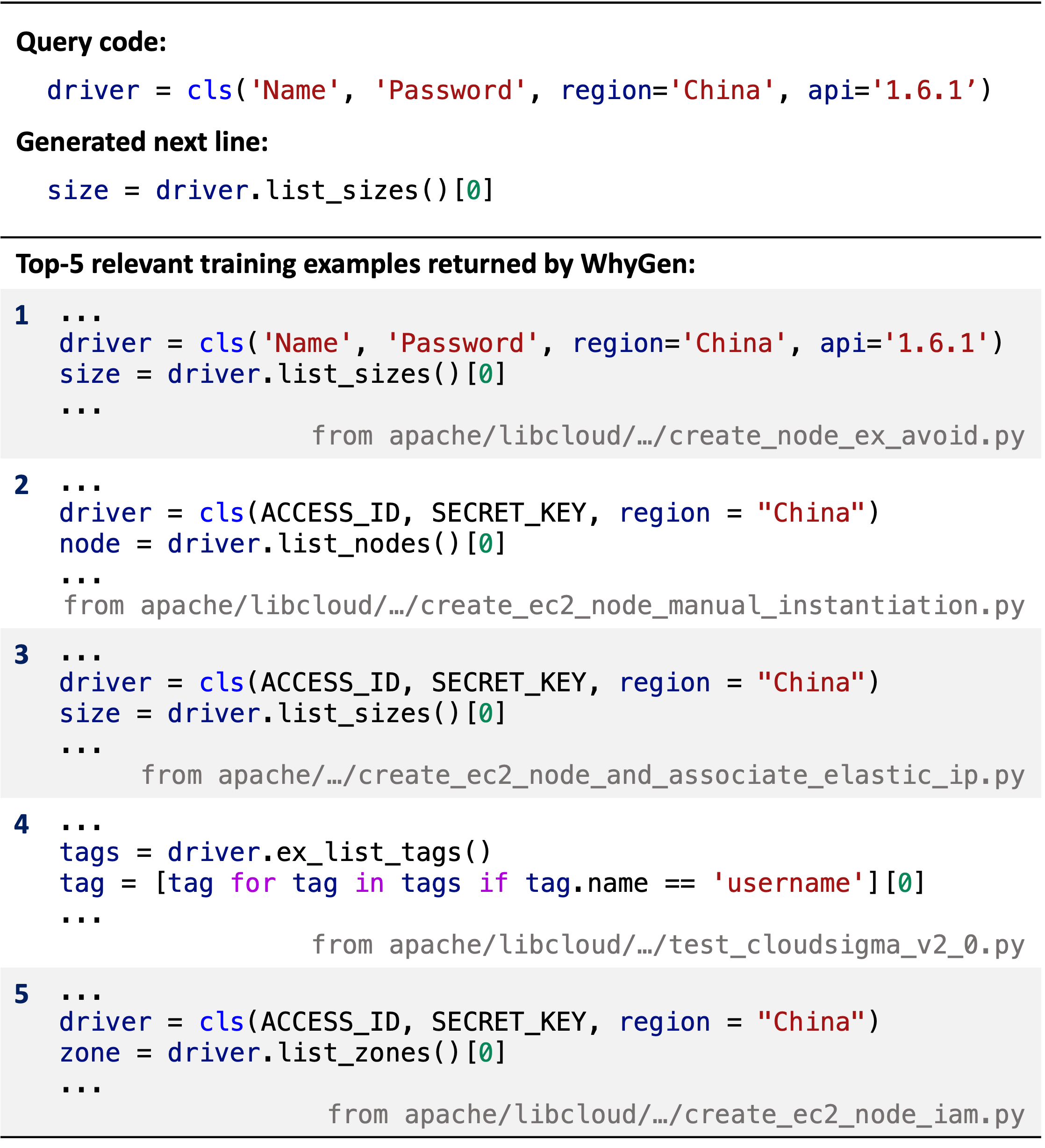Here we describe how to implement the CodeGPT model with training, inference and evaluation, and WhyGen to extract the neurons of the specified layer.
The workflow of WhyGen to explain DNN-powered code generation by examples.

CodeGPT completes the next line given on the previous context, and the model evaluates them by exact matching and edit similarity. In the process of generating the next line, WhyGen first records the neurons of the self-attention layer or the feed forward layer for test each data for statistical computation.
We use py150 dataset from Raychev's OOPSLA 2016 paper Probabilistic Model for Code with Decision Trees.
To download and preprocess the dataset, navigate to dataset/py150 directory, and run
bash download_and_extract.sh
python preprocess.py --base_dir=py150_files --output_dir=token_completionData statistics of py150 dataset are shown in the below table, note that there doesn't exist dev set in the origin py150 dataset, we select 5,000 files in the original train set as dev set.
| Data Split | #Files | #Tokens |
|---|---|---|
| Train | 95,000 | 72.1M |
| Dev | 5,000 | 4.4M |
| Test | 50,000 | 37.3M |
- Tokenization is applied.
- We normalize uncommon literals for better user experience. Developers sometimes leave their names, IP address, phone numbers in their codes, and we don't encourage models to focus on these string or numeric literals. So we normalized these literals by some special tokens. Considering that frequently used literals may contain useful information, e.g. "__main__" or "utf-8", we preserve the 200 most frequent string and 30 most frequent numeric literals. These literals will be normalized by tokens in
"<STR_LIT:utf-8>"format, while uncommon literals are replaced by<STR_LIT>or<NUM_LIT>. - We add
<s>and</s>to indicate the start and the end of one piece of code. <EOL>is added in python corpus to mark the ending of a line since in python there is no;or}to mark the ending of a statement like in java.
We use the first 1/2 part of each data as input according to the number of rows of data, and the next line as ground truth. Models are expected to generating the code sequence in the latter part until the first <EOL> token (excluding <EOL>).
Test set is already at dataset/py150/line_completion/inference/test.json.
We use the input of inference as the input of record neuron activations.
Test set is already at dataset/py150/line_completion/record/test.json.
Data is saved in json lines format files. Each line is a json object. To be consistent with token level code completion, codes have been tokenized. Here is an example of one line:
{
"rec_id": "2012",
"recitation_code": "@ pl announce ( ' ' )",
"input_code_id": 2012,
"input": "<s> from spockbot . plugins import default_plugins <EOL> from spockbot . plugins . base import get_settings , pl_announce <EOL> class PloaderFetch ( object ) : <EOL> def __init__ ( self , plugins , plugin_settings ) : <EOL> self . plugins = plugins <EOL> self . plugin_settings = plugin_settings <EOL> def get_plugins ( self ) : <EOL> return self . plugins <EOL> def get_plugin_settings ( self , plugin ) : <EOL> return self . plugin_settings . get ( plugin , { } ) <EOL> @ pl_announce ( '<STR_LIT>' ) <EOL>"
}
We provide a script to evaluate predictions for this task, and report exact match score and edit similarity. You can run the script like this:
python evaluator/evaluator.py -a=evaluator/answers.json -p=evaluator/predictions.txtThe outputs are:
| Model | EM | Edit similarity |
|---|---|---|
| CodeGPT-adapted | 42.37 | 71.59 |
Note that when evaluating, the normalized literals will be converted to the original format, e.g. <NUM_LIT:1> => 1, '<STR_LIT>' => ''
A legal prediction file is expected to be a txt format file. It should have the same number of lines as answer file. Each line is the model prediction for the corresponding input in answer file. For example, one line in the answer file is:
{
"input": "<s> from __future__ import absolute_import , division , print_function <EOL> from . _ithreads import AlreadyQuit <EOL> class Quit ( object ) : <EOL>",
"gt": "def __init__ ( self ) :"
}
And the corresponding line in your prediction file is:
def __init__ ( self ) :
We used the CodeGPT-small-py-adaptedGPT2 model on the Hugging face website (this model comes from CodeXGLUE, a work of Microsoft Research Asia), and then we used the py150 dataset for fine-tuning to fit our work.
- python 3.6 or 3.7
- torch==1.6.0
- transformers>=2.5.0 and < 4.0.0
- fuzzywuzzy
To fine-tune CodeGPT on py150 dataset for code completion in multi-GPU on a single machine, navigate to code directory, run:
LANG=python
DATADIR=../dataset/py150/token_completion
LITFILE=../dataset/py150/literals.json
OUTPUTDIR=../save/py150
PRETRAINDIR=microsoft/CodeGPT-small-py
LOGFILE=completion_py150.log
PER_NODE_GPU=YOUR_GPU_NUM # modify YOUR_GPU_NUM
python -m torch.distributed.launch --nproc_per_node=$PER_NODE_GPU run_lm.py \
--data_dir=$DATADIR \
--lit_file=$LITFILE \
--langs=$LANG \
--output_dir=$OUTPUTDIR \
--pretrain_dir=$PRETRAINDIR \
--log_file=$LOGFILE \
--model_type=gpt2 \
--block_size=1024 \
--do_train \
--gpu_per_node $PER_NODE_GPU \
--learning_rate=8e-5 \
--weight_decay=0.01 \
--evaluate_during_training \
--per_gpu_train_batch_size=2 \
--per_gpu_eval_batch_size=4 \
--gradient_accumulation_steps=4 \
--num_train_epochs=5 \
--logging_steps=100 \
--save_steps=1000 \
--seed=42 \
--overwrite_output_dir \
--not_pretrainWe stop at 50000 steps on py150 experiment, which takes 25 hours, and experiments run on 2 NVIDIA P100.
It's recommanded to run inference on single GPU. The predictions will be saved at $OUTPUTDIR/predictions_line.txt
export CUDA_VISIBLE_DEVICES=0
LANG=python
DATADIR=../dataset/py150/line_completion
LITFILE=../dataset/py150/literals.json
OUTPUTDIR=../save/pythonCorpus
PRETRAINDIR=../save/javaCorpus/checkpoint
LOGFILE=completion_pythonCorpus_eval.log
python -u run_lm.py \
--data_dir=$DATADIR \
--lit_file=$LITFILE \
--langs=$LANG \
--output_dir=$OUTPUTDIR \
--pretrain_dir=$PRETRAINDIR \
--log_file=$LOGFILE \
--model_type=gpt2 \
--block_size=1024 \
--eval_line \
--logging_steps=100 \
--seed=42 It might take 45 minutes for inferencing on py150 dataset on a single NVIDIA P100.
It's recommanded to run inference on single GPU. The predictions will be saved at Mongodb as test_input_activations.
export CUDA_VISIBLE_DEVICES=0
LANG=python
DATADIR=../dataset/py150/line_completion
LITFILE=/../dataset/py150/literals.json
OUTPUTDIR=../save/pythonCorpus
PRETRAINDIR=../save/javaCorpus/checkpoint
LOGFILE=completion_pythonCorpus_eval.log
python -u run_lm.py \
--data_dir=$DATADIR \
--lit_file=$LITFILE \
--langs=$LANG \
--output_dir=$OUTPUTDIR \
--pretrain_dir=$PRETRAINDIR \
--log_file=$LOGFILE \
--model_type=gpt2 \
--block_size=1024 \
--eval_line \
--logging_steps=100 \
--seed=42An example of relevant training examples returned by WhyGen.

If you find this repository useful in your research, please cite the following paper:
@inproceedings{WeixiangYan2022WhyGenEM,
title={WhyGen: Explaining ML-powered Code Generation by Referring to Training Examples},
author={Weixiang Yan and Yuanchun Li},
year={2022}
}
For questions, please feel free to reach out via email at g.weixyan@gmail.com.